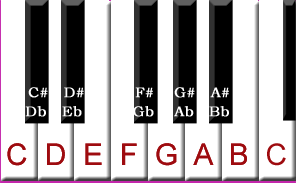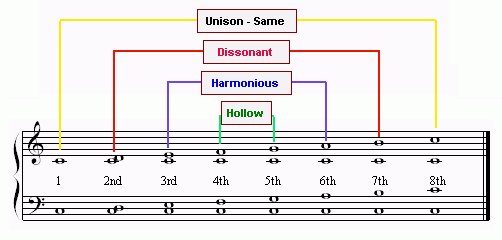The Distance between Two Notes
Let’s explore the element of music theory intervals. The distance between two notes is the determination of an interval.
What is special about intervals is that they are easily defined and shown by the number of half steps from a starting note.
We are not going to attempt to explain the pitch differences but only explain the interval idea. The names will give clues and explore them in wikipedia will give you an in depth understanding. We are most concerned at this stage with the application or math of the music theory intervals.
Interval Names Overview
The names of an intervals are stated in such terms as a second, third, fourth, fifth, and continue up to fifteenths.
What is more difficult is that for a name it can be modified for different position with some of these modifiers M=major, m or (-) = minor, #=sharp, b=flat, octave=8va which change the position.
We might say minor 6th. which is a half step down from a sixth.
Now that can start to be confusing and we are not about to let that happen.
Music Theory Intervals in One Octave:
We have defined the 7 base note names,
A – B – C – D – E – F – G.
By using the keyboard below starting on the C note we can examine the basic interval from 2nd to 8th (octave) by using just the white keys. (This is the key of C, the C scale, and has no sharp or flats, the black keys)

2nd to Octave:
The first rule of working with intervals is that the note you start with is called 1 or unison. Pretend like you were placing the same note on two instruments the interval between them would be one or in unison playing the same note.
Going from C to the next white key will give you an interval. C to D is a 2nd. C to E is a 3rd and so forth until you get C to C which is the 8th, and Octave.
The following measure shows the intervals for the C octave.

Here are the rules for finding music theory intervals.
| Interval | Example | Label |
| Second (2 half steps) |
C to D | 2 |
| Third (4 half steps) |
C to E | 3 |
| Perfect Fourth (5 half steps) |
C to F | 4 |
| Perfect Fifth (7 half steps) |
C to G | 5 |
| Sixth (9 half steps) |
C to A | 6 |
| (Major) Seventh (11 half steps) |
C to B | M7 |
| Octave (12 half steps) |
C to C (8va) | 8 |
The Seventh is labeled major because the other seventh we will explore later is the dominate 7th and is typically referred to when we say seventh.
What you have just learned above are the intervals related to the major scale. When applied any major scale can be created using these intervals and half step rules.
Interval Sounds
The following graphical example labels sound characteristics which will help you understand the interval in music. Use these to play and identify the sound of an interval.

Making the Interval Minor
The 2nd, 3rd, 5th, 6th, and 7th can all be made minors by stepping down a half step.
Once you know the major intervals it’s time to move onto the next set of minor intervals. There are other rules to explore in detail on later lessons associated with music theory intervals with scales and chords. Check out the workshops below to learn and master note intervals.

